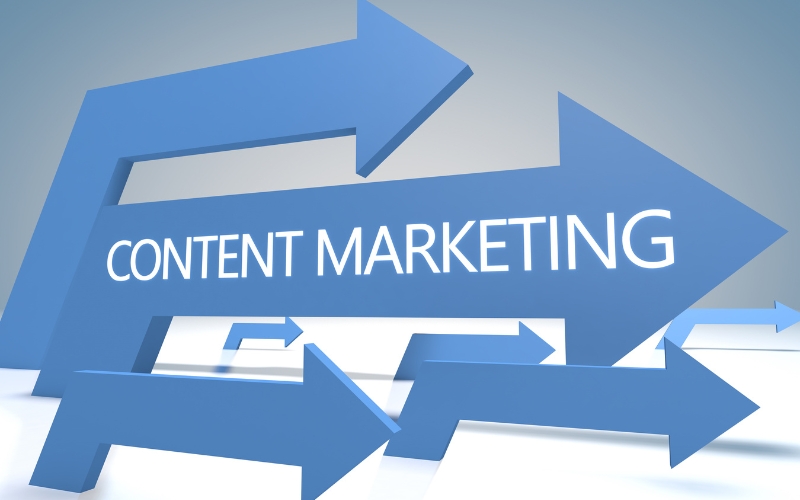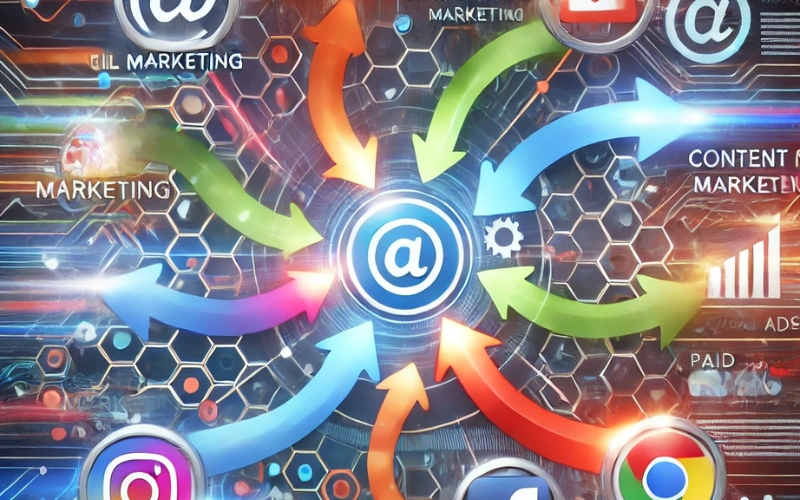In the fast-paced digital marketing landscape, businesses are constantly seeking innovative ways to enhance their strategies and maximize return on investment (ROI). One of the most effective methods for achieving this is by combining email marketing with other digital marketing channels. When strategically integrated with social media, content marketing, and paid advertising, email marketing can reach new heights in terms of engagement, conversions, and overall business growth. In this article, we will explore how these digital channels work together to drive success. We’ll discuss how to use social media to capture email sign-ups, leverage content marketing to improve email engagement, and harness the power of paid ads to boost email list growth and conversions.
How to Integrate Email Marketing with Social Media Campaigns

Integrating email marketing with social media campaigns can be a game-changer for your digital marketing strategy, driving engagement, increasing brand awareness, and boosting conversions. Both email marketing and social media serve distinct purposes, but when used together, they complement each other to maximize return on investment (ROI). Here’s how to seamlessly integrate these two channels for better results.
Benefits of Using Social Media to Promote Email Campaigns
Social media platforms like Facebook, Instagram, LinkedIn, and Twitter offer unique opportunities to promote email campaigns and grow your email list. One of the main benefits of using social media is the ability to tap into your audience where they are most active. Social media platforms have billions of active users, making them an ideal place to reach new prospects and encourage them to join your email list.
By sharing email content, sneak peeks, or exclusive offers on social media, you can create a sense of urgency and exclusivity, enticing followers to subscribe to your email list. Additionally, these platforms allow you to target your content to specific demographics, ensuring that your email campaigns reach the right audience. This can help generate higher-quality leads, which can result in better engagement and conversions when you send them your emails.
Using Social Media Ads to Capture Email Sign-Ups
Running social media ads is another powerful way to drive traffic to your email list. Platforms like Facebook, Instagram, and LinkedIn offer advanced targeting options, which allow you to reach users based on their interests, demographics, and behaviors. For example, you can create a lead-generation campaign on Facebook or Instagram, offering a valuable lead magnet such as an ebook, discount code, or webinar in exchange for their email address.
Here are some effective strategies for using social media ads to capture email sign-ups:
- Create visually appealing ads that align with your email content, showcasing the value of what users will receive in your email campaigns.
- Use clear CTAs (Call-to-Actions) in your ads, such as “Sign up for exclusive deals” or “Subscribe for the latest updates.”
- Offer incentives like discounts or free resources to encourage users to provide their email addresses.
By running these ads and driving traffic to a dedicated landing page or sign-up form, you can significantly increase the number of email subscribers and set the stage for future email marketing success.
Encouraging Social Media Followers to Open and Engage with Your Emails
Once you’ve captured email sign-ups through social media, it’s important to continue leveraging those platforms to encourage subscribers to open, read, and engage with your emails. Cross-promotion between your social media profiles and email content can help maintain interest and boost engagement.
Here are a few tips:
- Share email sneak peeks on social media: Give your followers a preview of what’s coming in your next email to create anticipation and encourage them to open it once it lands in their inbox.
- Use social proof: Highlight positive testimonials or reviews on social media from users who have benefited from your emails or offers.
- Engage with subscribers on both platforms: Invite your email subscribers to follow your social media accounts for real-time updates, and vice versa. This creates a continuous cycle of engagement, where both channels complement and enhance each other.
By cross-promoting your email content and making your social media and email marketing efforts work together, you create a unified strategy that boosts both engagement and conversions. When done effectively, integrating email marketing with social media campaigns can lead to a highly engaged, loyal audience that is eager to interact with your brand across multiple touchpoints.
Combining Email Marketing with Content Marketing for Better Engagement

Email marketing and content marketing are two powerful tools that, when combined, can significantly boost engagement, nurture leads, and drive conversions. By integrating these strategies, you can deliver a consistent message, enhance the customer experience, and achieve higher ROI. Here’s how to use blog posts, videos, infographics, and content personalization to create a seamless strategy that aligns your email and content marketing efforts.
How to Use Blog Posts, Videos, or Infographics to Enhance Email Campaigns
Content marketing and email marketing go hand in hand when used strategically. Blog posts, videos, and infographics provide rich content that can be shared directly in email campaigns to engage subscribers. These content types not only inform your audience but also provide value that keeps them interested in your brand.
For example, if your latest blog post addresses a trending industry topic, you can highlight it in your email campaign, providing a snippet or key insights with a link to the full article on your website. This drives traffic to your blog while also keeping your email subscribers informed.
Videos and infographics are visually appealing and tend to drive higher engagement rates. Including a video thumbnail or infographic in your email can significantly increase click-through rates. For instance, a product demonstration video or an infographic outlining key statistics can catch the attention of readers, compelling them to take action.
Incorporating multimedia into your emails keeps the content dynamic and engaging, offering a diverse content experience that appeals to various types of learners and preferences.
The Importance of Aligning Content Strategies Across Both Channels for Consistent Messaging
When combining email marketing with content marketing, consistency is key. Ensuring your content strategy is aligned across both channels helps reinforce your message and builds a stronger connection with your audience. Whether you’re promoting a new product, sharing insights, or offering discounts, your message should be consistent in tone, language, and visuals.
For example, if your email promotes a new blog post, the email should reflect the same key themes and messaging as the blog post itself. Similarly, if you’re running a content campaign on social media or your website, you should continue the same narrative in your email marketing efforts. This consistency helps your audience stay engaged and ensures they don’t get confused or overwhelmed by conflicting messages.
Moreover, aligned content across both channels reinforces brand identity and credibility, allowing your subscribers to feel confident in the value you’re providing.
Leveraging Content Personalization in Emails Based on Customer Behaviors and Interests
Personalization is one of the most effective ways to boost engagement in email marketing. By analyzing customer behavior and preferences, you can deliver tailored content that resonates with your audience on a deeper level. This could mean recommending blog posts based on previous reading history, sending personalized offers, or delivering content that aligns with the recipient’s purchase behavior.
For example, if a customer has previously downloaded an e-book, you can send them a follow-up email with related blog content or a video that expands on the topic. This level of personalization not only makes the content more relevant to the individual but also increases the likelihood of conversion.
By leveraging data from both email interactions and content consumption, you can refine your email marketing strategy to offer valuable, targeted content that drives deeper engagement.
In conclusion, combining email marketing with content marketing enhances engagement by offering valuable content, maintaining consistent messaging, and leveraging personalization to meet the needs of your audience. This integrated approach creates a seamless experience for your customers, increases brand trust, and improves overall campaign performance. By strategically aligning content and email marketing, you can ensure better engagement and ultimately higher ROI.
Using Paid Advertising to Boost Email List Growth and Conversions

Digital marketing, especially paid advertising, such as Google Ads and Facebook Ads, can be a powerful tool for building your email list and driving conversions. When integrated effectively within your digital marketing strategy, paid ads create a seamless funnel that guides potential customers from ad exposure to email sign-ups and ultimately to higher conversions. Here’s how to use paid advertising in your digital marketing plan to maximize email list growth and boost your return on investment (ROI).
The Role of Paid Ads in Digital Marketing for Email List Building
Paid ads are an essential component of digital marketing, helping expand your reach and drive targeted traffic to your website or landing page, where visitors can sign up for your email list. Platforms like Google Ads and Facebook Ads offer advanced targeting options that align perfectly with digital marketing goals, ensuring relevant traffic reaches your email sign-up forms.
For instance, Facebook Ads allow you to target users based on location, age, and interests, while Google Ads can target search queries relevant to your business. By incorporating compelling ad copy and visuals into your digital marketing campaigns, you can highlight the benefits of joining your email list, such as exclusive content or discounts, encouraging sign-ups directly from the ads.
How to Create a Seamless Funnel That Aligns Digital Marketing with Email Sign-Ups
A well-executed digital marketing funnel ensures a smooth transition from ad interaction to email sign-up. Start by designing ads that align with your digital marketing objectives. For example, if you’re offering a free e-book, ensure your ad clearly communicates this incentive, with a strong call-to-action (CTA) like “Get your free e-book now.”
Once users click on the ad, they should land on a dedicated landing page that reinforces the offer and integrates seamlessly with your digital marketing efforts. The landing page should be optimized for conversions, keeping the design simple and mobile-friendly.
To further enhance your digital marketing funnel, streamline the process with lead generation ads. Platforms like Facebook and Instagram allow users to sign up directly within the ad, minimizing friction and boosting conversion rates.
Integrating Email Retargeting in Digital Marketing to Maximize Conversions
Email retargeting is a critical aspect of digital marketing, allowing you to re-engage users who interact with your ads but don’t complete the desired action. For example, if someone clicks on your Facebook ad but doesn’t fill out the sign-up form, a follow-up email within your digital marketing strategy can remind them of the offer and encourage them to take action.
Once users join your email list, follow-up campaigns should deliver content that aligns with your digital marketing goals. For example, if your ad promised a discount, send a welcome email with the promo code and continue engaging users with valuable content that leads them toward a purchase.
By integrating email retargeting into your digital marketing campaigns, you create a cycle of engagement that nurtures leads and drives conversions.
Conclusion
Incorporating paid advertising into your digital marketing strategy creates a powerful, multi-channel approach to drive engagement, boost conversions, and build a loyal customer base. By leveraging digital marketing tactics, such as social platforms, content integration, and retargeting, businesses can amplify their efforts, ensuring higher ROI. A cohesive digital marketing approach allows each channel to support and enhance the others, driving sustainable growth and success.

